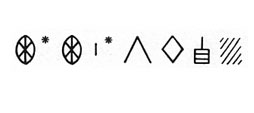The Problem of ‘Reconstructed’ Indus Inscriptions
It is important never to rely on the linear representations of Indus inscriptions found in concordances, catalogs, and studies of Indus symbols, since these often badly distort the data.
Five Cases of ‘Dubious Writing’ in Indus Inscriptions (1.6 Megs), pp. 4 and 16, give illustrations of typical types of mistranscriptions and questionable conflations of signs in the concordances. The “Harappan Lunar Calendar” according to Fairservis (PDF file, 376 K) concerns an unsupportable ‘reconstruction’ of a different type. The pictures below illustrate a third problem involving hand-drawn reconstructions of inscriptions.
In Deciphering the Indus Script (1994: 108; cf. pp. 116-17), Asko Parpola claims that a “distinctive sequence of seven Indus signs” shows up repeatedly on a series of Mohenjo-daro seals, sealings, and weapons. The claim is important, since the seven-sign sequence ends in what Parpola (who never questions the old idea that Indus signs are part of a fully enabled ‘script’) tells us may be a “royal title.”
As part of his evidence, Parpola reproduces a photo of a copper axe with highlighted signs drawn in. The caption tells us that the inscription is “drawn after” Mackay 1938: II, plate 126: 2 and plate 131: 31. Parpola also refers to the Photo Archive of the Archaeological Survey of India, Sind vol. 17, p. 80: 403-4. But since Indus inscriptions on copper objects photograph poorly — they are usually drawn over by hand — it is apparent (as the text suggests) that Parpola’s main source is Mackay.
Parpola’s argument seems powerful — unless you take the time to check out Mackay. When you do, you find that Mackay, who had the original axe in hand, did not see the signs that Parpola claimed over a half century later were found there. The upshot is that Parpola’s reading is an unlabeled reconstruction that includes several signs that Parpola assumes should be found on the partially illegible inscription. We cannot check Parpola’s drawing against an unretouched photo in the Corpus of Indus Seals and Inscriptions, since Parpola did not include a modern photo of the axe in the first two volumes of that work.
Remarkably, in Mahadevan’s 1977 concordance we find a third representation of the same inscription that differs on key points from those given both by Parpola and Mackay. The upshot is that arguments based on drawn reconstructions of Indus inscriptions must be taken cum magno grano salis — or, even better, should be disregarded entirely.
Below is the evidence from Mackay, Parpola, and Mahadevan displayed side-by-side. Many similar examples exist in the literature: Caveat lector!

This is how the axe appeared to Mackay, who had the original in his hands. Reproduced from Mackay, Further Excavations at Mohenjo-daro 1938: II, plate 126: 2. The assumption is that the inscription is to be ‘read’ from top to bottom.

This is how Parpola 1994: 108 represents the same inscription, which he tells us is “drawn after” Mackay 1938, II, plates 126: 2 and 131: 31. Obviously Parpola went way beyond the evidence in Mackay, including (among other differences) added signs.
It is important for Parpola to find all the signs drawn here to support his claim that the same sequence is found on several other elite objects from Mohenjo-daro. The supposed ‘reading’ again goes from top to bottom.

Here is Mahadevan’s ‘normalized’ reading of the same inscription (Mahadevan 1977, p. 85, #2923, side 1). In this case, we are supposed to ‘read’ it from right to left.
The rectangle with angular lines on the far right is Mahadevan’s symbol for damaged or illegible signs (represented rather clearly in Parpola’s reconstruction, nonetheless); the asterisks refer to uncertain readings; on these codes, see Mahadevan 1977: 19).
Feb 2023 format changes from web server migration.
